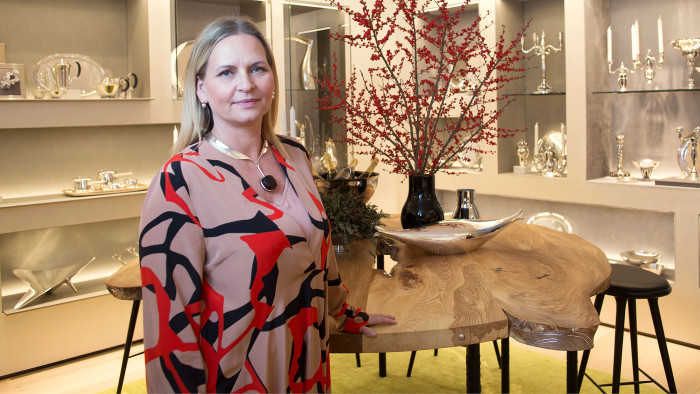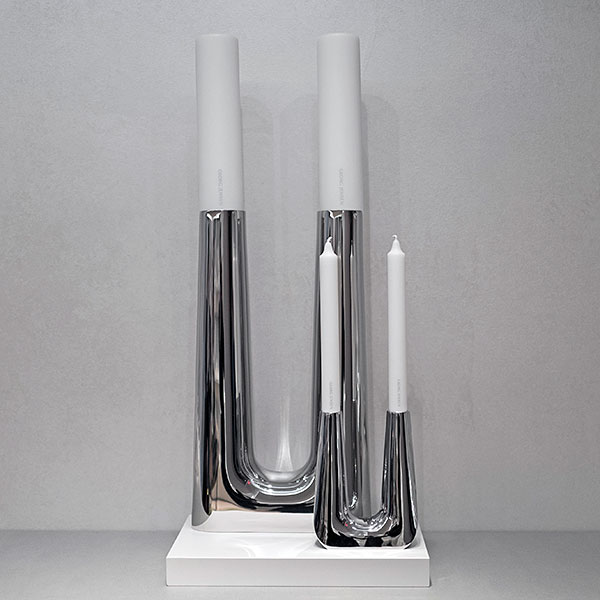Interview: Georg Jensen’s chief executive, Eva-Lotta Sjöstedt

Roula Khalaf, Editor of the FT, selects her favourite stories in this weekly newsletter.
It is a frigid day in Manhattan but Eva-Lotta Sjöstedt, chief executive of silver specialists Georg Jensen, is willing to exchange the warmth of its new Madison Avenue flagship and brave the cold to demonstrate how the Danish design brand defines itself.
The shop’s minimalist window display of modern silverware and jewellery, set against a curving wall of natural moss, catches the attention of passing shoppers as she stands outside. It is in contrast with the traditional face of high luxury represented by neighbours including Hermès and Graff Diamonds.
“If you don’t like Scandinavian design, you probably shouldn’t come in,” laughs the Swede, who was appointed in January 2016 to drive growth, integration and digitisation at the 113-year old company.
The fact that only now has Georg Jensen appointed its first female chief executive is perhaps surprising given that staffing at the company’s Copenhagen headquarters is 82 per cent female. In addition, every country manager is female and the global management team is half female.
Ms Sjöstedt hopes to capitalise on the growth Georg Jensen has already enjoyed. In 2015 revenue grew 13 per cent to DKr1.14bn ($164m) while operating profit grew from DKr2m to DKr44m. This can be attributed, according to the company, to homeware and jewellery sales, as well as increased ecommerce and new retail locations in London, Taipei and Munich. In Beijing, Georg Jensen has a “concept store” with a restaurant called The Georg, serving “new Nordic fusion cuisine”.

Watches, by contrast, have suffered alongside the overall fall in the Swiss watch market, where exports were down 10 per cent in a year. Ms Sjöstedt says that the company will streamline its offering accordingly, focusing on core models such as the women’s Vivianna bangle and the men’s Koppel watches.
Koppel watches are mostly priced from $1,100-$1,600, which may not seem like premium stock for Madison Avenue. However, with jewellery, homeware and silver hollowware costing up to six figures, the flagship is not out of place on one of Manhattan’s most luxurious shopping streets. Ms Sjöstedt resists the luxury label, however: “We do not use the word ‘luxury’. We use ‘design’ and ‘accessibility’,” she says.
Ms Sjöstedt, a former senior executive at Ikea, adds that the terms “luxury” can be interpreted in many different ways. She wants Georg Jensen to be defined as a master of Scandinavian design, a style that “is both functional and democratic”, providing high-quality conception and craftsmanship no matter what a customer’s budget.

Now Ms Sjöstedt needs to communicate this message across a formerly disparate business, where the different product categories and countries were managed — and marketed — in a less unified way.
In September, the brand, which has 100 stores around the world, launched its first digital campaign with the somewhat cosy slogan, “You can never be too much you”. In late spring, the company plans to roll out an improved mobile-enabled ecommerce site to complement its in-store experience.

While unifying the company’s ethos and message has been a priority since her arrival, Ms Sjöstedt also says it is essential that Georg Jensen’s website and its product and distribution mix can be tailored to individual markets. In New York, London and Australia, for example, the company will continue to focus on the higher-end hollowware and bespoke jewellery pieces for which there is already a strong customer following. In Taiwan, where Ms Sjöstedt says the company’s current customers tend to be older and are less comfortable buying online than in some markets, investment will be aimed at more traditional retail distribution.
Georg Jensen’s Madison Avenue boutique puts into practice some of the changes Ms Sjöstedt has introduced. It is a smaller, brighter space than belonged to its predecessor.
With Scandinavian-style blond wood and textured opalescent-silver walls, it tips its hat to Georg Jensen’s storied past as well as to its future: the sterling silver signage created at its Copenhagen smithy for its original New York shop in 1924 sits alongside a wall of screens displaying the digital campaign.

To create a more intimate environment inside the store, the traditional counter that divides staff and clients has been replaced by a custom-made wooden smithy table, inlaid with silver, to give the feeling of “being at a party and standing around the kitchen table”. All transactions now take place behind the scenes at the rear of the shop.
Ms Sjöstedt’s mantra of accessibility means that customers can handle pieces here without asking the staff. Certain items are presented in the open, on top of locked vitrines housing others. “It’s like an exhibition, but one where you can touch and feel the product,” says Ms Sjöstedt, who must wait and see how Georg Jensen’s customers respond to her gleaming vision of democratic design.
Comments